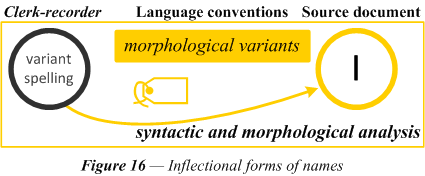
1.5 Inflectional forms. The clerk as recorder intentionally creates a variant spelling by systematically using a form appropriate to the name’s syntactic context. The record has an oblique case form written for the nominative form of the name. Normally the nominative case is preferred as the citation form.

For example, the Latin given name “Johannes,” was transliterated from Greek “Joannes,” which in turn was borrowed from the Aramaic. The name may appear in different forms in Greek according to its use in the sentence or other context as “Joannis,” “Joannem,” or “Joanne,” and these were brought into Latin as “Johannis,” “Johannem,” or “Johanne.” The following table has entries for a selection of classical names in their Latin transliterated version that fall into the first three declensions of that language. Each declension represents a paradigm for a set of nouns manifesting the same suffixes in seven distinctive syntactic uses. The gender of a noun in Latin is either masculine, feminine, or neuter, which form is important when it becomes necessary to harmonize grammatically, i.e. be in agreement with certain other words, i.e., substantive or verbal modifiers, within the structure of the noun phrase in which the name is the head noun.
| Case |
| |||||||||||||||||||||||||||||||||||||||||||||||||||||||||
|---|---|---|---|---|---|---|---|---|---|---|---|---|---|---|---|---|---|---|---|---|---|---|---|---|---|---|---|---|---|---|---|---|---|---|---|---|---|---|---|---|---|---|---|---|---|---|---|---|---|---|---|---|---|---|---|---|---|---|
|
|
There may also be erroneous forms based on ignorance of the Latin use of Greek, or there may be preferential usage in a vernacular language: “Johannus,” “Johannes,” “Johanno,” etc.
Figure 17 illustrates two uses of the genitive suffix in Danish. The study of surnames containing patronymic suffixes discloses many examples of this inflection added to a given name before the suffix under consideration is attached to the given name. The suffix {–s} is thus an inflectional morpheme when added to a name to show possession by the individual referred to. This is normal in most the Nordic languages. In Danish the genitive often merges with the {–sen} of the masculine patronymic. The second example contains (an abbreviation of) {–datter}, the feminine patronymic, which may attach to the surname as a derivational morpheme. Hence, in the name on the left, the {–s} has become derivational with the patronymic suffix yielding a new surname, which as a noun is then inflected.

